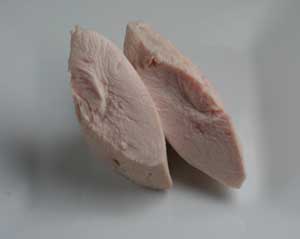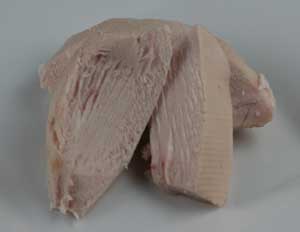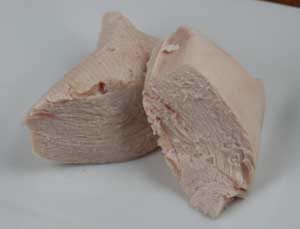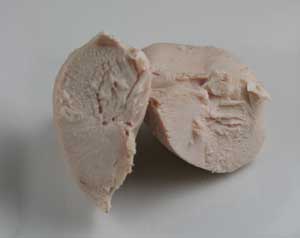Why does meat shrink when cooked?
Why does meat become dry when cooked --And, why does confit cooking keep meat moist?
The amount of liquid water expelled from muscle fibers is related primarily to the temperature the meat is heated to. Meat that is cooked above 160F can become dry as water from the meat is release. Meat that is cooked in an oven exposed to air will cause water to evaporate from its surface and over time dry out the meat.
How does temperature affect the breakdown of proteins in meat?
Connective tissues such as tendons and ligaments contain large amounts of collagen which makes the meat we eat very tough..
Collagen begins to denature at 140°F/60°C squeezing meat fibers leading to a release of juices (containing water) and shrinkage.
At 160F collagen will begin to dissolve and turn into a rich liquid, gelatin. This will give meat flavor and a silky texture.
Note: Gelatin is a mixture of peptides and proteins formed from broken down collagen. Gelatin is soluble in ot water and forms a gel when cooled. -- show image of released gelatin at bottom of duck confit which shows gelatin bound to released water.
Denaturation of the collagen molecule is a kinetic process, and hence a function of both temperature and duration of heating. Cooking at low temperatures require long periods of time to liquify collagen.
Elastin which is found more frequently in older animals is a yellow connective tissue and does not break down in cooking. Elastin is found primarily in ligaments but also in smaller amounts in tendons.
BREAST MEAT IN POULTRY
158°F /70°C -- Breast meat in birds gets dry as collagen contracts and meat gets tougher.
165°F/ 73°C -- Leg meat is full of connective tissue and is chewy if cooked below this temperature.
NOTES: Collagen (fibrous protein constituting a good part of meat) contracts and gets tougher over 70°C/158°F. Thus, the tip is to cook below this temperature to keep the meat tender for breast meat.
Chicken Breast Cooked Sous Vide using the Sous Vide Supreme It appears the best temperature range to cook chicken breasts sous vide is in the 140-147F range. Cooking times will vary depending on the thickness of the breast being cooked and the degree of safety desired. |
In the following procedures: no prior salt was added to the vacuum bag.
 |
137F (Cooking Time -- 120 minutes) Weight of Chicken before -84 grams after 77 grams weight loss = 8.4% cooking time 2 hours Comments: Had excellent flavor with some meaty texture not found at higher temperatures. Retained a lot of moisture. Requires longer cooking times to ensure pasteurization. |
 |
140F (Cooking Time -- 90 minutes) 140F is where myoglobin begins to change color, and shrinkage begins. Weight of Chicken: before -82 grams after 74 grams weight loss =9.8 % Chicken now has a pleasant soft white texture. This is the temperature that Heston Blumenthal likes to cook his chicken. Chicken is moist and tender... This may benefit further with short brine. |
 |
147F --(Cooking time 45 minutes) Weight of Chicken: before -84 grams after 74 grams weight loss =11.9 % Still retains sufficient moisture similar to that cooked at 140F. Texture and taste was similar to cooking at 140F.This may benefit further with short brine. |
 |
160F (Cooking Time -- 45 minutes) Weight of Chicken: before -84 grams after 64 grams weight loss =23.8% This is the recommended temperature since pasteurization occurs very quickly, however meat was very bland tasting, dry with a chewy consistency not found at lower temperatures. |
Science of Cooking
See also:
Science of cooking with brown butter
How to prevent ice crystals from forming in sorbet Taste Molecules --